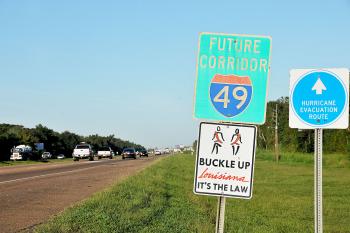
Tolls are considered to complete Interstate 49 from Lafayette to New Orleans. The photo was taken this morning on U.S. 90 in Berwick on the westbound lane.
(The Daily Review Photo by Crystal Thielepape)
Tolls possible to complete I-49 South
A state-funded feasibility study finds tolls starting at 18 cents a mile could pay from one-quarter to one-half of the more than $3 billion price tag to complete I-49 South from Lafayette to New Orleans, but the state senator leading the charge says it was “not a very well thought-out study.”
Sen. Bret Allain, R-Franklin, said the state Department of Transportation and Development-commissioned study — looking at the financial feasibility of tolling the entire 145-mile stretch from Lafayette to New Orleans or tolling only segments within that stretch, with tolls collected in each segment supporting work only in that segment — was revealed during a Monday meeting in Lafayette.
The study found that tolls collected along the entire 145-mile route could pay from 26 percent to 51 percent of the project.
The numbers were similar — 27 percent to 53 percent — if tolls were collected only on the portion from I-10 stretching 59 miles south to the Wax Lake outlet.
The figures looked better for a 50-mile stretch about midway between Lafayette and New Orleans — toll funding could pay for 54 percent to 106 percent of the project — but most of that portion is already complete.
The study assumes tolls starting at a rate of 18 cents a mile and rising over 15 years to 25 cents a mile.
Allain and others said they were disappointed Monday that the feasibility study didn’t find the toll revenue could pay for a bigger chunk of I-49 South.
“We realize this is not necessarily the best of news,” said Dennis Decker, assistant secretary of multimodal planning for Department of Transportation and Development.
On the phone this morning, Allain added: “They did the report how they had done the sections of tolling in the past … there were three sections that were originally studied back in the ’80s and they didn’t redo the criteria.”
Allain added, “There have been many sections completed since then and they didn’t redo the criteria of what should be tolled. As far as I’m concerned, it was not a very well thought-out study.”
He said the plan now is to “regroup with DOTD and express our concerns.”
The Advocate reports discussions of tolls are in the early stages, but supporters for pushing forward I-49 South said the study shows that a mix of toll revenue with federal and state money could pave the way for the road.
The senator said, “We’ve got to look at other funding sources. If you are to complete I-49 in our lifetime, you’re going to have to consider tolls. If we don’t do tolls, it probably wouldn’t get done … tolling existing roads is going to be a very hard sell. Almost politically impossible.”
Michael Copeland, a planner with consultant CDM Smith, the company that did the toll feasibility study, said the numbers should not be discouraging.
“It’s very rare for a facility nowadays to completely pay for itself,” he said.
DOTD has done several projects in recent years that have brought much of U.S. 90 up to interstate standards.
Allain said, “I’m in favor of asking the people if they want a toll to complete I-49 South and looking at all revenue sources, but it has to be dedicated funds and it has to be for specific purposes and sections that aren’t already done. People have to know what they’re paying for and agree to pay for it.”
In July, DOTD Secretary Sherri LeBas said in a news release, “The completion of I-49 South is a priority for the state. With the support of Gov. Jindal, we’re able to pursue innovative ways, such as the design-build method, to move us one step closer to achieving our goal of upgrading U.S. 90 to interstate standards.”
DOTD issued a notice of intent in July seeking a design-build firm to construct the next section of I-49 South, the U.S. 90/La. 318 interchange in St. Mary Parish, the release stated.
The proposed project includes upgrading the existing U.S. 90 and La. 318 intersection to a full control of access, grade-separated interchange including the reconstruction of the U.S. 90 frontage roads to provide local access to La. 318, according to the release.
The estimated project cost is $55 million to $65 million and will be funded by a combination of federal and state funds. The contract is expected to be executed in June 2015 and completed in three years.
The Associated Press contributed to this report.
- Log in to post comments
